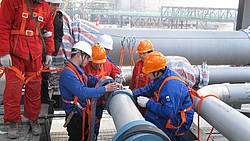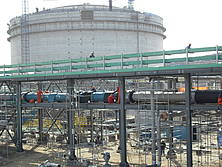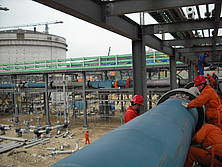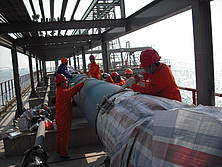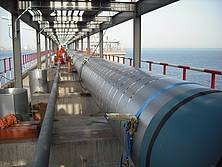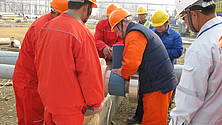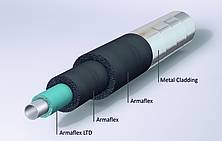Münster (Germany), 11 July 2012 – At the end of 2011, China National Petroleum Corporation (CNPC), China’s largest state-owned oil and gas company, began trial operation of its new LNG plant in Nianyu Bay near the port of Dalian. For the insulation of the cryogenic pipework in the largest LNG plant in China so far CNPC relied on ArmaFlex Cryogenic Systems, the flexible multilayer systems for line temperatures down to -200 °C made by Armacell.
LNG increasingly important for global energy supply
Liquefied natural gas (LNG) is becoming more and more important for the energy supply. By cooling natural gas to -162 °C, it is reduced to one six-hundredth of its volume and can therefore be transported economically by LNG tankers. Today, around a quarter of the global trade in natural gas is already carried out in the liquefied state and throughout the world LNG will play an increasingly important role in securing supply. The advantage of LNG is the flexibility: independent of pipelines, natural gas can be transported over great distances by tankers. This means that gas reserves can be used for gas supply whether or not pipelines are available. This reduces the dependence on individual supplier countries and increases the security of supply. In north-western Europe, the LNG terminal operated by Fluxys in Zeebrügge (Belgium) functions as a central gateway for the natural gas supply. The Belgian natural gas grid operator plans to greatly extend the LNG capacities by 2016. In 2014, Fluxys intends to open a second landing stage on which LNG tankers with a capacity of up to 217 000 m³ LNG can be unloaded. Moreover, a new LNG storage tank with an additional capacity of 160 000 m³ is planned. China is also relying more and more on natural gas for its energy supply. To meet the growing demand for energy, the state is investing billions in the construction of natural gas pipelines and LNG terminals. Within five years ten new LNG plants are to be built and the use of liquid gas is to be doubled.
Requirements of cryogenic insulation materials
The storage and transportation of cryogenic media such as LNG, LPG, LEG or methanol and ammonia require high-performance insulation systems. Because if the insulation system is damaged, the consequences are much greater in cryogenic applications: faults can soon compromise the process control and the quality of products. In addition, production costs would increase dramatically. Important selection criteria when choosing the insulation material are the lowest possible energy losses during liquefaction, low evaporation losses and, of course, safe storage of the refrigerants. A key requirement is that condensation is prevented and the risk of corrosion under the insulation is minimized. Furthermore, the insulation must absorb the tremendous vibrations and impact resulting from the extreme temperature cycles. Apart from the materials used, the technical construction of the insulation system plays a critical role. Materials traditionally used in this field are rigid foams (on the basis of PUR/PIR, for example) or cellular glass, which are combined with additional vapour barriers and/or contraction joints.
Flexible insulation systems for cryogenic applications
With ArmaFlex Cryogenic Systems, Armacell is the first manufacturer of insulation materials to offer flexible insulation systems specially developed for applications at extremely low temperatures. The multilayer systems for temperatures ranging from -200 to +125 °C ensure exceptional thermal insulation, reduce the risk of corrosion under insulation (CUI) and allow significant cost savings during the installation process. ArmaFlex Cryogenic Systems maintain their flexibility even at extremely low temperatures. ArmaFlex LTD, a diene terpolymer with a glass transition temperature which is lower than ever previously achieved, ensures that vibrations and impact are absorbed and the risk of cracking as a result of extreme temperatures cycles is significantly reduced. A key advantage of the cryogenic foams is that, unlike insulation materials made of rigid foams, these systems need neither additional expansion joints nor vapour barriers. This allows great reductions in installation costs compared to traditional insulation materials.
Built-in expansion joint
The system itself, which is still flexible at very low temperatures, acts as an expansion and contraction joint. Thus the insulation is protected against thermal stress and cracking. In the case of traditional rigid foam systems, expansion joints made of glass wool or mineral fibre are used. This not only increases the installation costs; due to the open-cell material structure of the expansion joints, the risk of moisture infiltrating the system and compromising the insulation effect rises considerably.
Built-in vapour barrier
ArmaFlex is a closed-cell material with a high resistance to water vapour transmission and as such has a built-in vapour barrier. Unlike traditional systems where each insulation layer must be protected against moisture infiltration by a separate vapour barrier, in ArmaFlex the resistance to water vapour transmission is built up throughout the entire insulation thickness. This not only increases the reliability of the insulation system, but also reduces the installation costs significantly as there is no need for the time-consuming process of installing vapour barriers with sealants and special adhesive tapes.
ArmaFlex Cryogenic Systems in China’s largest LNG plant
ArmaFlex Cryogenic Systems were installed for the first time on a large scale in the Chinese Dalian project. In summer 2007, CNPC, China’s largest state-owned oil and gas company, began to build its first LNG plant in Nianyu Bay near the port of Dalian with a total investment of over 1 billion euros. The result is the country’s largest LNG port, where tankers with a capacity of up to 200 000 m³ can dock. The project is being realized in two phases: initially, 3 million tonnes of LNG are to be converted into 4.2 billion m³ of natural gas annually; in the second phase, the capacity is to be doubled to 6 million tonnes of LNG. The liquid natural gas is sourced mainly from Australia and Qatar. For insulating the cryogenic pipework and other installations in the Dalian LNG terminal the Beijing-based consultant engineering firm, China Huanqiu Contracting & Engineering Corporation (HQCEC), specified Armacell’s flexible multilayer insulation systems for cryogenic applications.
Local project support
In the Dalian project, all LNG process and vaporization pipes (including pumps, valves and other fittings) were insulated with the multilayer system. The pipes had diameters of 1 to 40 inches (outer diameters of 33.7 – 1 016 mm) and were protected against condensation and energy losses using insulation thicknesses of 50 to 175 mm. In total, Da Shun Petrochemical Engineering Company (DPEC) from Dongying (Shangdong Province) installed 15 000 m² of ArmaFlex LTD, 27 000 m² of ArmaFlex LT sheets and 3 000 m of ArmaFlex tubes. Depending on the requirements, between two and seven layers of insulation material were used.
Throughout the specification and installation phase of this highly demanding project, the 80 DEPC employees were supported by five teams of Armacell application specialists. They were responsible for project management, calculating insulation thicknesses and supervision and also provided regular application training. The insulation work on the pipeline, which is around 7 km long, was carried out from January to September 2011. At the end of the year, CNPC began trial operation of the LNG plant.
Highly efficient insulation systems prevent unnecessary energy losses
Particularly in such energy-intensive industries as the liquefaction of natural gas it is crucial to prevent inadequate insulation leading to energy losses and thus unnecessary costs. Highly efficient insulation systems not only safeguard the operation of the plant, but also reduce process and maintenance costs and protect the environment by reducing CO2 emissions.
Additional information
Info 1: Cryogenics – Interesting factsCryogenics (from the Greek kryos ‘frost, ice’) is the technique concerned with producing very low temperatures and using physical effects at low temperatures. Today, processes with cryogenic gases are used in many different sectors: in the steel industry special metal alloys are produced with the aid of liquid nitrogen, freeze drying is a common procedure for preserving foodstuffs, and in the pharmaceutical and chemical industries many applications are only possible through the use of cryogenic media. Nowadays, economic growth is inconceivable without petrochemicals such as ethylene, LPG (which consists of propane and butane), LNG or inorganic ammonia. And these gases can only be transported throughout the world if they have been liquefied.
Info 2: Extensive research into the behaviour of elastomeric insulation materials at cryogenic temperatures
Elastomeric insulation materials have proved themselves for many years in the insulation of refrigeration systems and in cryogenic applications too. However, at temperatures below -50 °C, products on the basis of NBR (nitrile butadiene rubber) tend to harden. Below this temperature, which is also known as the glass transition point, the mechanical behaviour changes and the rubber increasingly loses its flexibility. Although the hardening of the material is completely reversible, i.e. when temperatures rise the material regains its original flexibility, in the past the lack of strength had to be taken into account in the overall construction. The aim of Armacell’s research and development work was to develop an elastomeric insulation material with a much lower glass transition point. In cooperation with the University of Southampton, the company carried out extensive research into the behaviour of elastomeric insulation materials at cryogenic temperatures and now Armacell’s knowledge of this special field of application is unique in the industry.
